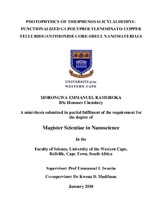Photophysics of Thiophenosalicylaldimine-functionalized G1-Polyprolyleniminato-Copper Telluride/Antimonide core-shell Nanomaterials
Abstract
This work involves the synthesis of copper telluride-polypropylenimine tetra(5-(2-thienyl)
salicylaldimine) (CuTe@PPI) and copper antimonide-polypropylenimine tetra(5-(2-thienyl)
salicylaldimine) (CuSb@PPI) core-shell nanoparticles (NPs), using two-pots and one-pot
synthesis methods, respectively. Their morphology was studied by X-ray diffraction
spectroscopy (XRD), high resolution transmission electron microscopy (HRTEM) and high
resolution scanning electron microscopy (HRSEM); while their structures were characterized by
Fourier transform infrared spectroscopy (FTIR) and elemental analysis. Photophysical properties
of the core-shell NPs were determined from ultraviolet-visible absorption spectroscopy (UV-Vis)
and photoluminescence spectroscopy (PL). For core-shell NPs produced via two-pots method
only CuTe@PPI exhibited ? ? ?* and n ? ?* which indicate that CuSb@PPI produced via
two-pots method was unsuccessfully synthesized. The ? ? ?* and n ? ?* transitions indicate
the presence of polypropylenimine tetra(5-(2-thienyl) salicylaldimine) (PPI) on the surface of
CuTe NPs and CuSb NPs. FTIR confirmed coordination of PPI on the surface of CuTe NPs and
CuSb NPs by showing a shift in wavenumber of C=N group bands from PPI. HR-TEM showed
that the CuTe@PPI synthesized via one-pot method have a wide particles sizes distribution with
an average particles size of 13.60 nm while for CuTe@PPI synthesized via two-pots it was
impossible to determine the particles size due to aggregation. CuSb@PPI synthesized via twopots
method and one-pot method has a wide particles sizes distribution with an average size of
7.98 nm and 11.61 nm respectively. The average particles sizes determined by HR-SEM were
found to be 35.24 nm (CuTe@PPI two-pots method), 33.90 nm (CuTe@PPI one-pot method),
18.30 nm (CuSb@PPI two-pots method), and 16.18 nm (CuSb@PPI one pot method).

